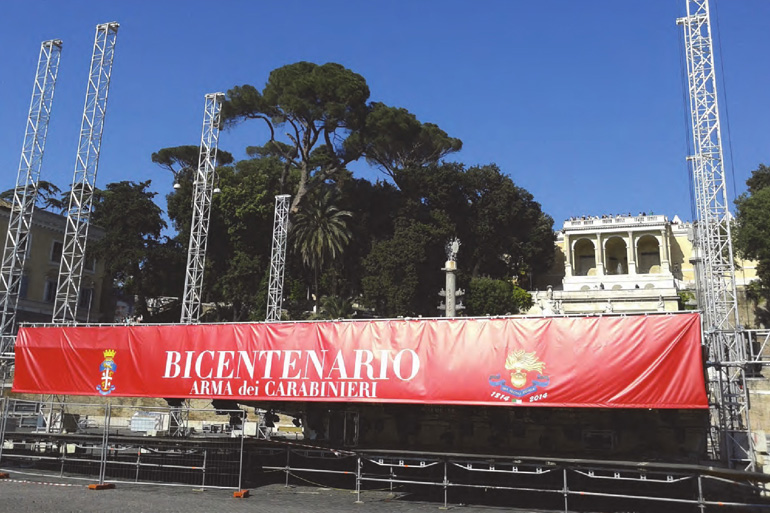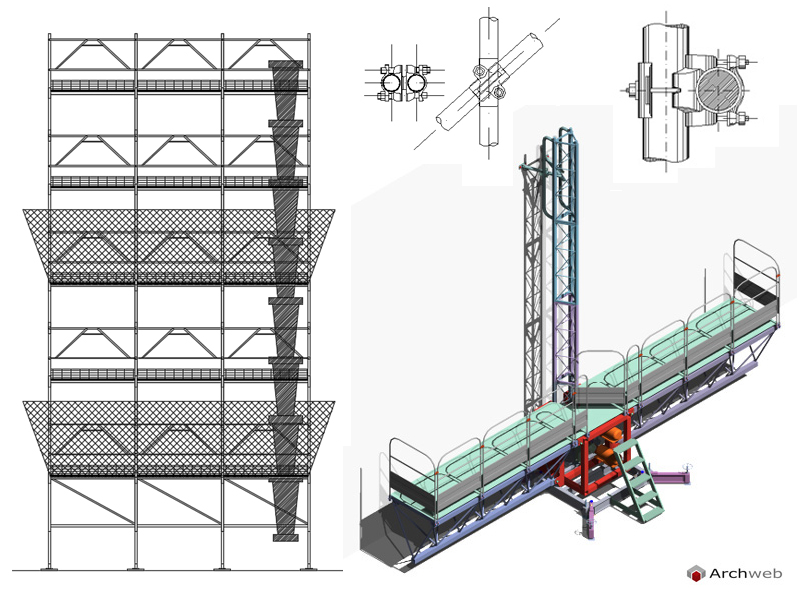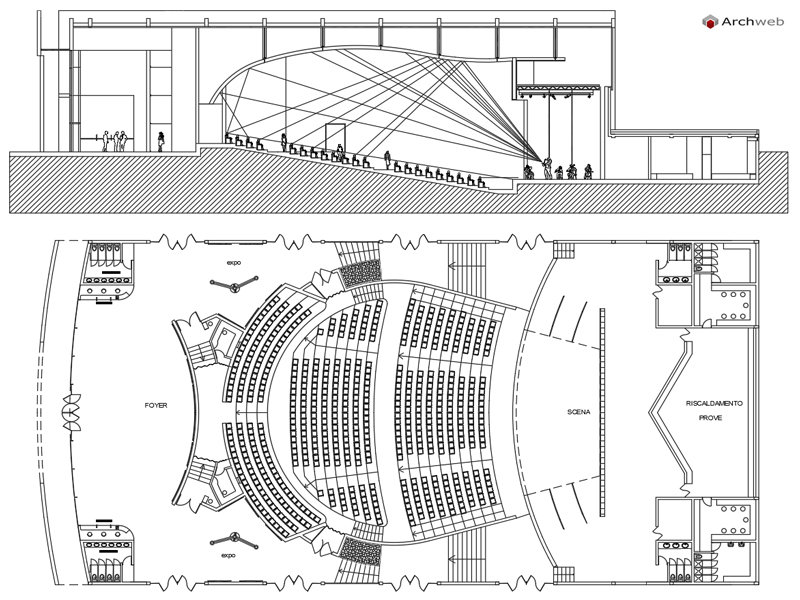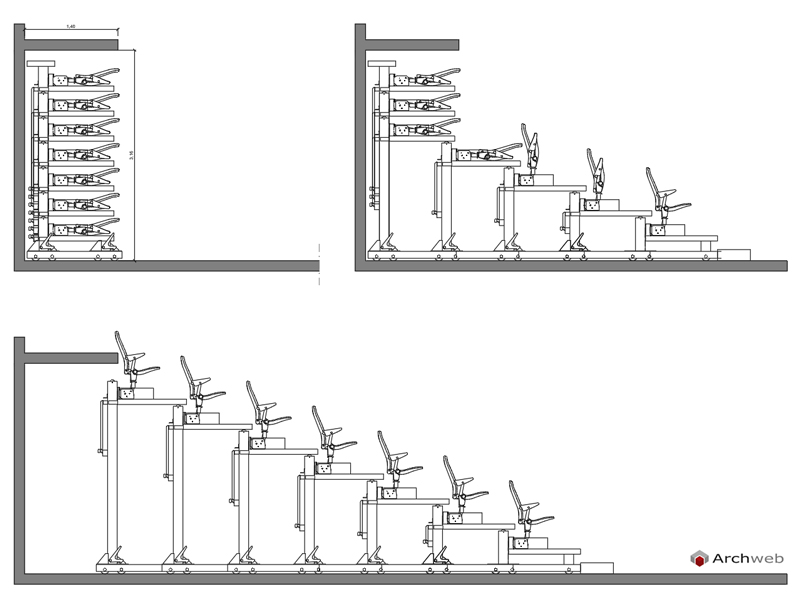Stages for shows and similar events
Laws - Rules - Guides
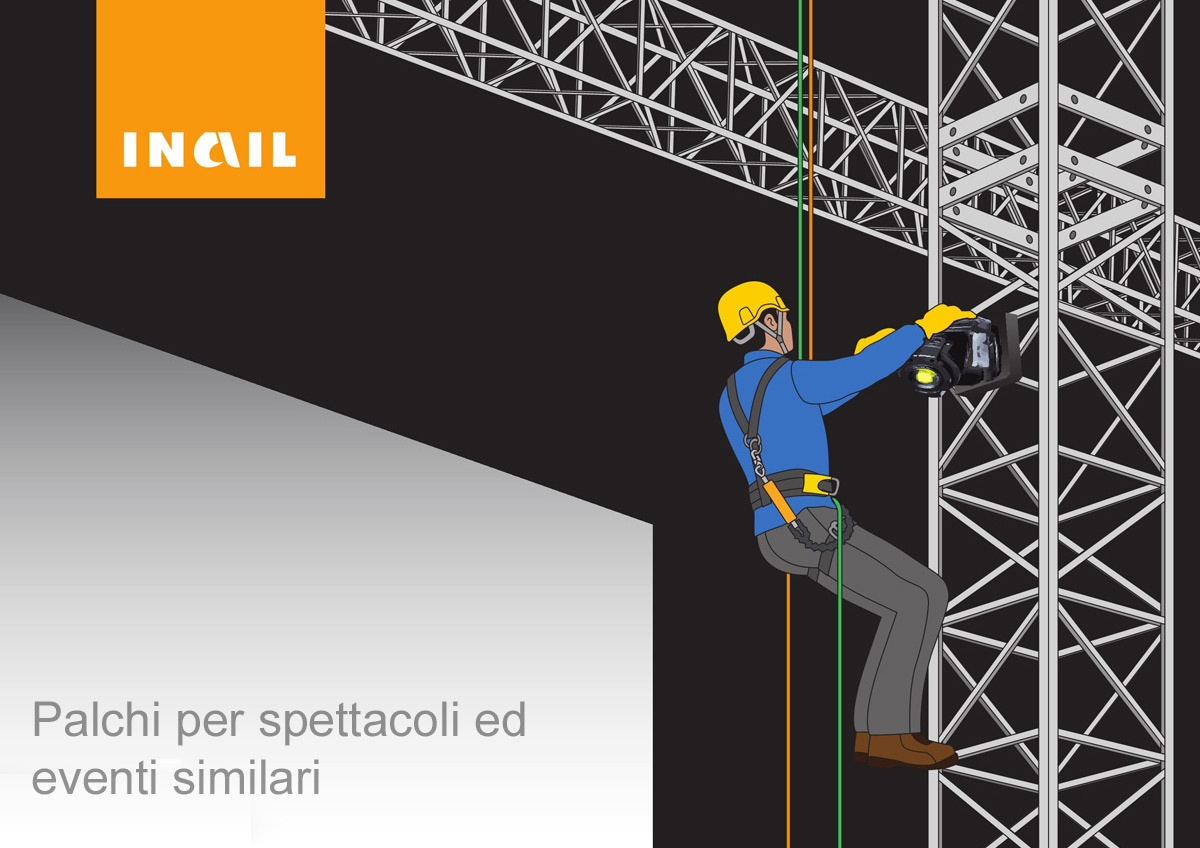
Premise
On 12 December 2011 in Trieste and on 5 March 2012 in Reggio Calabria, two young workers, Francesco Pinna and Matteo Armellini, lost their lives during the staging of the concerts by Jovanotti and Laura Pausini respectively.
The mourning events highlighted the potential risk present in the activities of assembly, disassembly and preparation of the temporary works used for shows, but also for exhibitions, trade fairs, cultural events and the like.
Promptly, the Ministry of Labor and Social Policies set up a working group to provide, in a document, practical tools applicable to all the aforementioned activities of assembly and disassembly of temporary works, including their assembly and disassembly with audio systems, lights , scenographers etc ..
The working group, made up of representatives of the same Ministry, Inail and the interregional technical coordination of prevention in the workplace, began the drafting of the ‘Technical-operational addresses for the preparation and management of temporary works and equipment to be use in the production and realization of musical, cinematographic, theatrical and entertainment’.
The drafting of the ‘Addresses’ continued until the publication of the law decree of 21 June 2013, no. 69 (so-called ‘Decree of doing’), coordinated with the conversion law 8 August 2013, no. 98, containing ‘Urgent provisions for the revival of the economy’.
With this decree the ‘musical, cinematographic and theatrical performances and trade fairs’ were included in the field of application of title IV ‘Temporary or mobile construction sites’ of Legislative Decree 81/08 and subsequent amendments, taking into account the particular needs connected with the performance of related activities, which had to be identified by decree of the Minister of Labor and Social Policies in agreement with the Minister of Health, after consulting the Permanent Advisory Commission for Health and Safety at Work, to be adopted by 31 December 2013.
The group had to interrupt the drafting of the ‘Addresses’, given that the future ‘Interministerial Decree 22 July 2014’, also known as the ‘Stage and Fairs Decree’, was in charge of drafting the decree in question musical, cinematographic and theatrical ‘and the’ trade fairs’.
Subsequently, in order to provide clarifications on the decree 22/7/2014, the Ministry of Labor, with the assent of the same working group, published circular letter no. 35 of 24 December 2014 containing the ‘Technical and organizational operating instructions for the preparation and management of temporary works and equipment to be used in the production and realization of musical, cinematographic, theatrical and exhibition events in the light of the Interministerial Decree of 22 July 2014’.
The working group then resumed the drafting of the ‘Addresses’ not yet published.
The issuance of the decree and the circular therefore went to fill gaps and uncertainties regarding the activities described up to now with particular regard to the design, assembly and disassembly, the preparation of the same in safety that took into account the particular needs of the operating context .
Introduction
The accidents that occurred during the staging of the concerts by Jovanotti and Laura Pausini suggested the idea of a research that would examine the technical tools available regarding the works temporary (hereinafter referred to as OT) and equipment to be used in the activities illustrated in the introduction.
The activities of assembly, disassembly and preparation of the OTs used for shows, exhibitions, trade fairs, cultural events and similar events are particularly risky if we consider the peculiarities of the operating context, such as, for example, the simultaneous presence of several contractors in the work areas, the high number of workers including of different nationalities and the need to complete the work quickly and in confined spaces.
Furthermore, these TOs are structures, generally prefabricated, which are installed, from time to time, in different places, having different characteristics, both from the point of view of the bearing capacity of the ground and of the meteorological conditions. These characteristics influence its structural design and stability, and must be evaluated at each site change.
The supply of OTs made for musical, cinematographic and theatrical shows, includes assembly and disassembly, set-up and dismantling with lighting, audio, video and general scenographic systems, related accessory processes, such as for example loading, unloading and handling of equipment .
The aim of the research is to identify and provide information from the national and international context, useful to public and private sector operators.
In this document, which takes stock of laws, regulations and guides in Italy, England and the USA, only one type of OT will be considered: boxes.
The availability of technical tools (laws, standards and guides) favors knowledge, study and analysis, thus contributing to the improvement of safety.
1. The Italian context
In Italy, the Ministry of Labor and Social Policies, with the support of the working group it set up and made up of representatives of the same Ministry, Inail and the Regions, has recently contributed to providing a set of reference documents for the ‘preparation and management of temporary works and equipment to be used in the production and realization of musical, cinematographic, theatrical and exhibition events.
From the legislative point of view, the decree law 21 June 2013, n. 69 (so-called ‘Decree of doing’), coordinated with the conversion law 8 August 2013, no. 98, containing ‘Urgent provisions for the relaunch of the economy’, establishes that ‘musical, film and theatrical performances and trade fairs’ are included in the field of application of Title IV ‘Temporary or mobile construction sites’ of Legislative Decree 81 / 08 and subsequent amendments.
The ‘Stage and Fairs Decree’, published in the Official Gazette no. 183 of 8 August 2014, takes into consideration both ‘musical, film and theatrical performances’ and ‘trade fairs’.
Circular no. 35 of 24 December 2014 published by the Ministry of Labor, with the consent of the same working group, contains the ‘Technical-organizational operating instructions for the preparation and management of temporary works and equipment to be used in the production and realization of musical performances , cinema, theater and trade fairs in the light of the interministerial decree of 22 July 2014 ‘.
Compared to what was planned, only the technical-organizational operational addresses for the preparation and management of temporary works and equipment to be used in the production and realization of musical, film, theatrical and exhibition events are missing, in light of the interministerial decree 22 July 2014 ‘on which the working group is working.
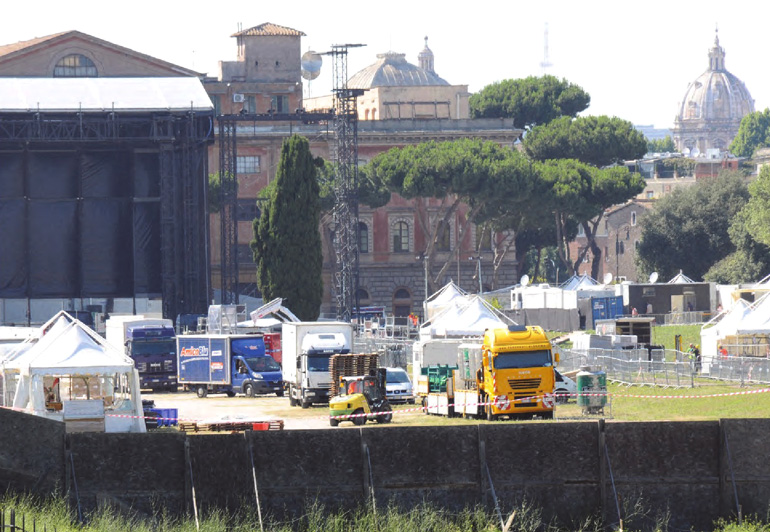
The three documents, the legislative decree, the ministerial circular and the operational guidelines, intend to fill gaps and uncertainties regarding the assembly and disassembly of temporary works and the equipment to be used in the production and realization of shows and similar events, with particular regard to the design, assembly and disassembly, to the preparation of the same in safety that take into account the particular needs of the operating context.
The following are the main contents of the published documents as well as considerations and indications taken from the technical regulations of the sector and from consolidated practices. As regards the decree and the circular, it will only deal with Chapter I, which deals with musical, cinematographic and theatrical performances, excluding Chapter II concerning trade fairs.
In the Appendix, the interministerial decree of 22 July 2014 and circular no. 35 of 24 December 2014.
1.1 Definitions
Temporary Work (OT)
There is no definition for OT in the Italian legislation. In this document the following definition is proposed: temporary work (OT) used for musical, cinematographic and theatrical performances, a civil engineering work that is designed to be assembled and disassembled several times, characterized by temporariness, as it must be removed after achieving the purposes for which it was designed and in any case within the periods set by the designer and which can be subsequently reused after adequate checks.
The OT considered in this document is the stage which consists of a platform, the vertical structures and the roof structure.
1.2 Technical standards
In Italy, there are no regulations issued by UNI regarding the temporary work as a whole, intended to be, for example, consisting of a platform, vertical structures, superstructures for supporting equipment and their handling, closing walls and roofing structure and concerning specifications for design, manufacture and control.
On the other hand, the European technical standard regarding tents installed on a traveling and temporary basis UNI EN 13782: 2006 – Temporary structures – Tents – Safety has been implemented. It specifies the safety requirements that must be observed in the design, calculation, construction, installation, maintenance, management, checks and tests of tents installed on a traveling and temporary basis with a covered area greater than 50 m2.
For tents with a covered area of less than 50 m2 it is not necessary to produce the tent booklet and the manufacturer will provide documentation regarding the fire behavior of the fabric and the stability of the structure. There is a UNI technical standard relating to the constituent elements of the OT, in relation to systems for public entertainment UNI 11580: 2015 – Systems for public entertainment – Specifications for the design, manufacture and inspections of structural elements in aluminum and / or steel.
It specifies the requirements for the design, calculation, manufacture, and inspection of beams, towers and any associated element, built in aluminum and / or steel for use in public entertainment. Structures composed of these elements can also have a complex shape through the use of corner elements, arches or combinations of other special elements that are not linear beams. Beams and towers are mainly used to support static and dynamic loads or for purely decorative purposes. They can be suspended, supported from the ground or on the wall, permanently installed or used as a mobile structure. In particular, the aforementioned rule refers, among other things, to provisions contained in other publications:
– UNI EN 1090-1 – Execution of steel and aluminum structures – Part 1: Requirements for the conformity assessment of structural components; Stages for shows and similar events 10;
– UNI EN 1090-2 – Execution of steel and aluminum structures – Part 2: Technical requirements for steel structures;
– UNI EN 1090-3 – Execution of steel and aluminum structures – Part 3: Technical requirements for aluminum structures;
– UNI EN 1991-1-1 – Eurocode 1 – Actions on structures – Part 1-1: Actions in general – Weights per unit of volume, own weights and overloads for buildings;
– UNI EN 1993-1-1 – Eurocode 3 – Design of steel structures – Part 1-1: General rules and rules for buildings;
– UNI EN 1999-1-1 – Eurocode 9 – Design of aluminum structures – Part 1-1: General structural rules.
There are also European technical standards which do not specifically concern the assembly, disassembly and installation of the OTs, but which affect the installations for spectators, which are listed below:
– UNI EN 13200-1: 2012 – Installations for spectators – Part 1: General characteristics of the observation spaces for spectators. It specifies the design and management requirements relating to spectator installations in permanent or temporary entertainment venues, including sports stadiums, sports halls, indoor and outdoor installations, in order to ensure their functionality.
– UNI EN 13200-3: 2006 – Installations for spectators – Part 3: Separation elements – Requirements. It specifies the design requirements for the arrangement and characteristics of the product for the separation elements within the installations for spectators in permanent or temporary entertainment venues including sports stadiums and sports halls.
– UNI EN 13200-4: 2007 – Installations for spectators – Part 4: Seats – Product characteristics. It specifies the mechanical, physical and chemical characteristics of the product of the fixed seats used in sports entertainment venues (indoors and outdoors) in the observation areas for spectators. The standard also specifies the criteria for fixing the seats to the structure.
– UNI EN 13200-5: 2007 – Installations for spectators – Part 5: Telescopic grandstands. It specifies the product characteristics for telescopic stands in permanent or temporary entertainment venues, including stadiums, gyms, indoor and outdoor installations. The stands of amusement parks and amusement parks are excluded from this rule.
– UNI EN 13200-6: 2013 – Installations for spectators – Part 6: Demountable (temporary) stands. It specifies the product characteristics for removable (temporary) grandstands in permanent or temporary entertainment venues, including sports stadiums, sports halls, indoor and outdoor installations. The stands of amusement parks and amusement parks are excluded from the norm.
– UNI EN 13200-7: 2014 – Installations for spectators – Part 7: Elements and routes of entry and exit. It specifies the safety and design features of the entry and exit passage elements that are used in spectator installations, either individually or in combination, in order to provide a path.
Further technical standards relating to steel constructions are those relating to the National Research Council:
CNR 10027: 85 – Steel structures for temporary works. Instructions for calculation, execution, testing and maintenance.
It specifies instructions that provide the calculation basis for the design of the steel structures of the temporary works.
These are divided into two categories: to the first belong the provisional road viaducts, the provisional stands, the structures Stages for shows and similar events 11 for events and advertising boards. To the second belong the temporary piers and ribs (also self-lifting), the equipment (also self-lifting) and the props for casting the concrete on site (for the piers, beams or arches of bridges; for dams and hydraulic works; for the lining of tunnels; for civil and industrial buildings), scaffolding, shooting castles and scaffolding.
The following are treated: loads, materials, checks and minimum thicknesses, calculation bases, limitations of displacements, resistance and stability checks of the constructive elements, anchors, drafting of the project, calculation and acceptance tests, use and maintenance.
1.3 Construction types of stages
The stages are formed by a complex of prefabricated elements connected to each other, each destined for a particular function and coordinated all together for a specific function (reception of artistic performance, cinema projection, theatrical representation, support of lifting equipment, screens video, cameras, speakers, lights, special effects, etc..).
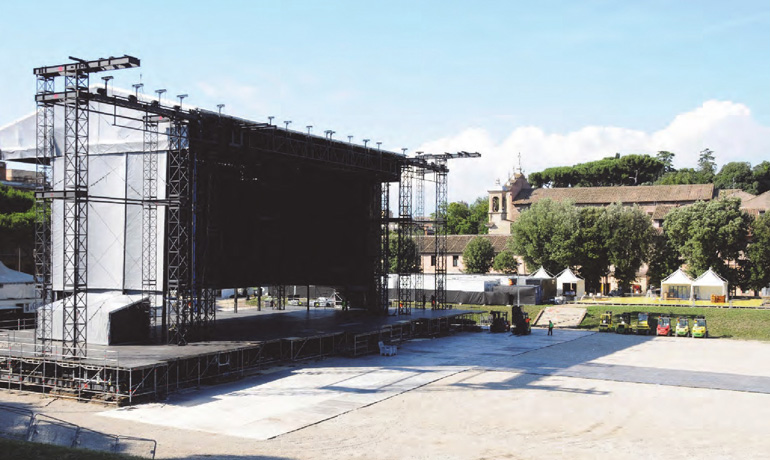
The stage is the OT above which the exhibition / representation / entertainment action takes place. The stage, usually made with a metal structure, is generally made up of a platform (or stage, possibly with steps with different height levels or inclined) and is equipped or not with covering elements. If present, the roof is built on site, generally on the ground and raised with manual or motorized lifting systems; it can be used to support audio, video, lighting and scenography equipment.
